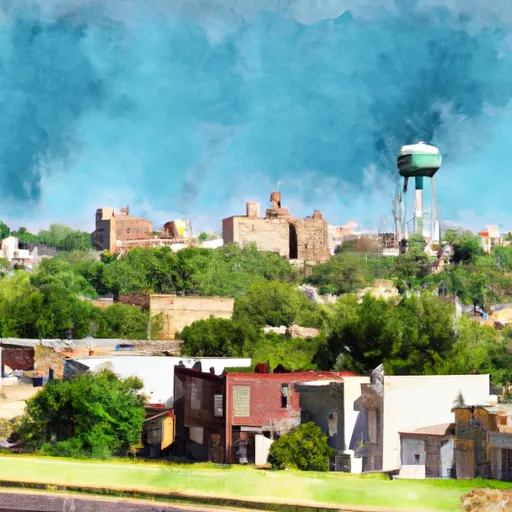-
 Snoflo Premium
Snoflo Premium
Get unlimited access to all our content
With no Ad interruptions! - Start Your Free Trial Login with existing account
Washington
Eden Index
Climate
8.1
•
Recreation
0.3
•
Community
1.4
•
Safeguard
3.7/10

Washington, Kansas is a charming town located in Washington County. It experiences a humid continental climate, characterized by hot summers and cold winters. Summers are typically hot and humid, with temperatures averaging in the high 80s°F (about 30°C). Winters, on the other hand, are cold and dry, with temperatures dropping to the low 20s°F (about -5°C). Rainfall is evenly distributed throughout the year, averaging around 35 inches annually.
The hydrology constituents in Washington, Kansas include the Republican River, which flows nearby, and several smaller creeks and streams that traverse the area. These water bodies provide opportunities for fishing, boating, and other water-based activities.
Outdoor recreation enthusiasts will find plenty of options in Washington. The nearby Lovewell State Park offers a range of activities such as camping, hiking, boating, and swimming in Lovewell Reservoir. The park is also known for its excellent fishing opportunities, with species like bass, crappie, and catfish abundant in the reservoir. Additionally, the region's scenic landscapes and rolling hills make it ideal for hiking, birdwatching, and wildlife viewing.
Overall, Washington, Kansas offers a diverse climate, beautiful hydrology constituents, and a variety of outdoor recreation opportunities for residents and visitors alike.
What is the Eden Index?
The Snoflo Eden Index serves as a comprehensive rating system for regions, evaluating their desirability through a holistic assessment of climate health, outdoor recreation opportunities, and natural disaster risk, acknowledging the profound impact of these factors on livability and well-being.
Climate Health Indicator (CHI): 8.1
Washington receives approximately
812mm of rain per year,
with humidity levels near 81%
and air temperatures averaging around
13°C.
Washington has a plant hardyness factor of
5, meaning
plants and agriculture in this region thrive during a short period during spring and early summer. Most
plants will die off during the colder winter months.
By considering the ideal temperature range, reliable water supplies, clean air, and stable seasonal rain or snowpacks, the Climate Health Indicator (CHI) underscores the significance of a healthy climate as the foundation for quality living.
A healthy climate is paramount for ensuring a high quality of life and livability in a region, fostering both physical well-being and environmental harmony. This can be characterized by ideal temperatures, reliable access to water supplies, clean air, and consistent seasonal rain or snowpacks.
Weather Forecast
Streamflow Conditions
Big Blue
Area Rivers
Big Blue
Snowpack Depths
Big Blue
Reservoir Storage Capacity
Big Blue
Groundwater Levels
Recreational Opportunity Index (ROI): 0.3
The Recreational Opportunity Index (ROI) recognizes the value of outdoor recreational options, such as parks, hiking trails, camping sites, and fishing spots, while acknowledging that climate plays a pivotal role in ensuring the comfort and consistency of these experiences.
Access to outdoor recreational opportunities, encompassing activities such as parks, hiking, camping, and fishing, is crucial for overall well-being, and the climate plays a pivotal role in enabling and enhancing these experiences, ensuring that individuals can engage in nature-based activities comfortably and consistently.
Camping Areas
| Campground | Campsites | Reservations | Toilets | Showers | Elevation |
|---|---|---|---|---|---|
| Milford State Park | 250 | 1,213 ft | |||
| Rock Creek Station State Rec Area | 35 | 1,339 ft | |||
| School Creek - Milford Lake | 45 | 1,175 ft | |||
| Farnum Creek - Milford Lake | 75 | 1,195 ft | |||
| Clay County Park | 240 | 1,160 ft | |||
| Timber Creek - Milford Lake | 45 | 1,152 ft | |||
| Diller City Park | 7 | 1,355 ft | |||
| Crystal Springs Lake | 60 | 1,314 ft | |||
| Washington City Park | 20 | 1,298 ft | |||
| Huntress City Park | None | 1,202 ft |
Catastrophe Safeguard Index (CSI):
The Catastrophe Safeguard Index (CSI) recognizes that natural disaster risk, encompassing floods, fires, hurricanes, and tornadoes, can drastically affect safety and the overall appeal of an area.
The level of natural disaster risk in a region significantly affects safety and the overall livability, with climate change amplifying these risks by potentially increasing the frequency and intensity of events like floods, fires, hurricanes, and tornadoes, thereby posing substantial challenges to community resilience and well-being.
Community Resilience Indicator (CRI): 1.4
The Community Resilience Indicator (CRI) recognizes that education, healthcare, and socioeconomics are crucial to the well-being of a region. The CRI acknowledges the profound impact of these elements on residents' overall quality of life. By evaluating educational resources, healthcare accessibility, and economic inclusivity, the index captures the essential aspects that contribute to a thriving community, fostering resident satisfaction, equity, and social cohesion.

